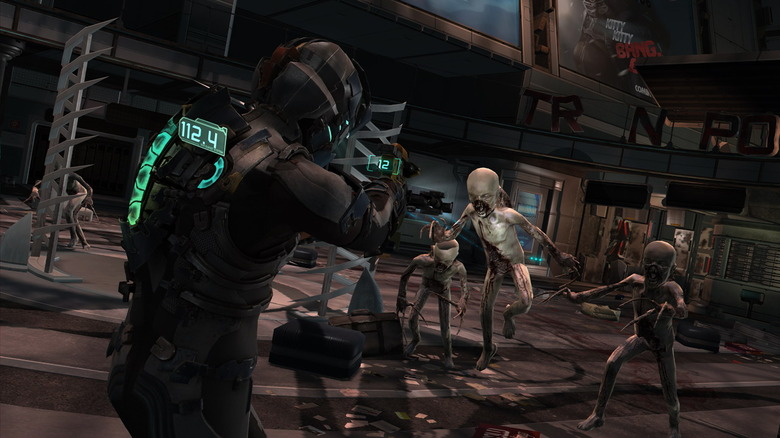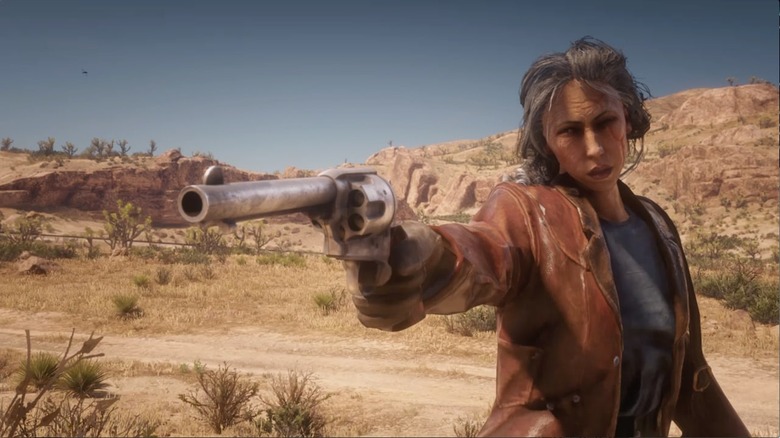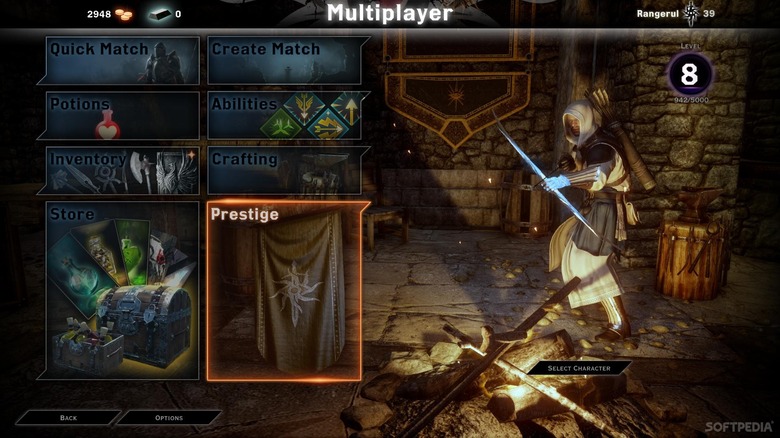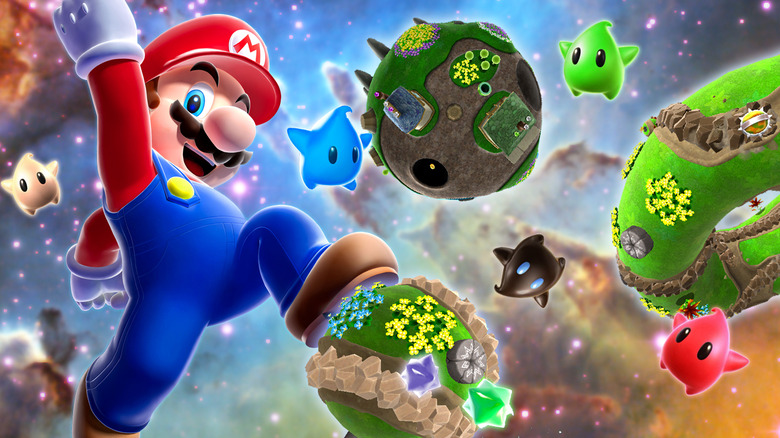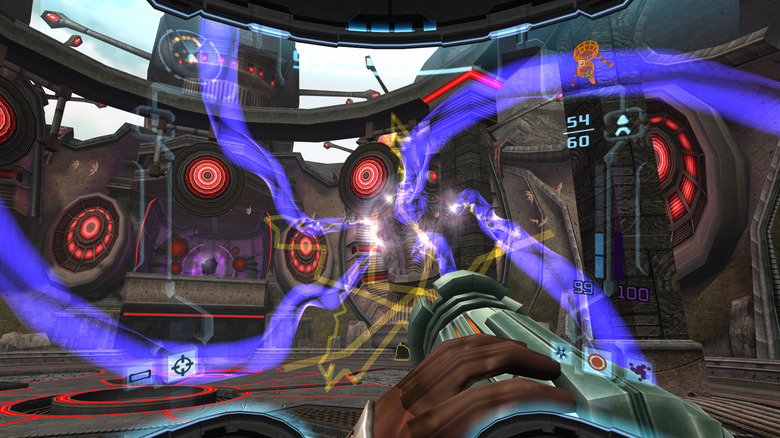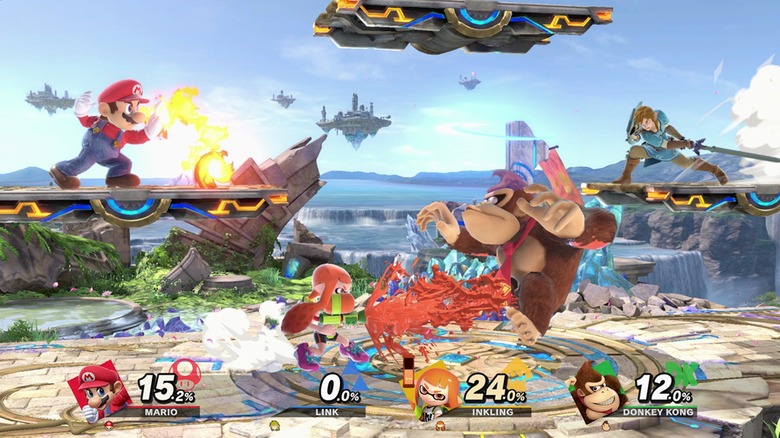Great Single-Player Games With Terrible Multiplayer Modes
There's nothing quite like a game that's the total package. Nice to look at? Check. Engaging gameplay? Loads of it. Innovation? The genre will look back on this game's release and remember the day everything changed.
Of course, these kinds of video game renaissances only manifest on rare occasions. More often than not, games end up lacking a key component that could have made them great. But what about the games that were great — and then somehow managed to have terrible multiplayer modes? The tools were all there in the single-player campaign, but something didn't click in multiplayer, and all we got were our hopes up for nothing.
These are some of the most frustrating instances of a truly great single-player game attempting to include a multiplayer mode and, for one reason or another, creating something inexplicably awful instead. Be warned: going through this list is a lot like watching those videos of somebody cutting a sandwich wrong. They were just so close to getting it right.
Dead Space 2
Dead Space 2 was a transcendent single-player experience. The game took the horror and survival elements of its predecessor and ramped them up to eleven, creating a tense atmosphere that rivaled the Alien franchise. On top of that, Dead Space 2 notably improved on the combat and design elements of the original, which made for a much more fluid play experience. Dead Space 2 is great. If you can handle Necromorphs attempting to kill you out of nowhere, it's a must-play.
The same cannot be said about Dead Space 2's multiplayer mode, however. Firstly, it forced people into open mic lobbies, which is a tough sell for anyone averse to having elementary school children screech at them. The mode itself also felt tacked on, featuring a team of generic Isaacs tasked with completing a bunch of objectives. On the other side of the equation was a team of Necromorphs, who, aside from getting to do cool stuff, also just had to stop the other team, no questions asked.
It was a lopsided design that didn't translate well in practice. Asymmetrical multiplayer modes certainly have a place in gaming — just look at games like Overwatch and Apex Legends — but Dead Space 2 didn't balance it well enough. The result was a disappointing multiplayer that only a Necromorph could love.
New Super Mario Bros. Wii
New Super Mario Bros. Wii represented a retro-style Mario experience on an innovative home console. It was the perfect blend of fresh technology and a tried-and-true formula. The level designs felt like home for a lot of old school Mario fans, but the graphics made it refreshing and eye-catching. The result was a single-player game that hooked lapsed and new Mario fans alike, which is the best case scenario for Nintendo.
New Super Mario Bros. Wii's multiplayer, though, left a lot to be desired. The biggest letdown was that there was no online multiplayer to speak of. New Super Mario Bros. Wii was local only, which forced people into wrangling friends into one physical location to play with them. That might not be difficult for kids, but for adults with families and jobs, it meant that they often had to forgo one of the experiences that made classic Super Mario titles so popular.
Beyond that, though, there was also another issue. There was only one way to clear levels in multiplayer mode, and it forced everyone to be perfectly in sync. Using the wrong abilities at the wrong time could be a complete disaster, resetting minutes of progress and turning friends on each other in the process. Controlling which direction everyone was heading in at once and preserving the right moves for specific situations made what should have been a fun experience into a Bowser-sized headache for everyone involved.
Dead Island
Dead Island made good on its promise of RPG, open-world, sandbox-style zombie fun. It might not go down in history as the greatest zombie game ever made (or even crack the top ten), but it was an entertaining excursion that felt different from every other horror game being produced at the time. It's a textbook example of a game finding a niche and thriving in it.
Dead Island was meant to be a co-op multiplayer experience that friends could enjoy together, too. That's not how it played out, thanks to a strange restriction placed on would-be parties. If players joined the campaign of someone who had progressed further than them, they would stop getting main story progress altogether, but they would retain side quest bonuses.
In theory, this approach makes some amount of sense. The developers likely wanted to prevent someone from getting the game and joining a friend mid-way through, skipping a lot of story content on the way. In practice, though, it forced friends who wanted to play through together to always sync up where they were in the story, lest they fail to progress in their own game should they want to finish it on their own. Forcing players to schedule their fun is always a tall ask, and Dead Island wasn't up to it, leaving behind a promising co-op mode many fans have already forgotten about.
Far Cry 5
Far Cry 5 was an ambitious look into a world that the series had never attempted to venture into before. Trading jungles, mountains, and exotic wildlife for rural America, Far Cry 5 had all the trappings of a great adventure game seen through a new, fast-food-and-gun-loving lens. Some of the insights presented during the adventure were also uncomfortable and, while some would say Far Cry 5 didn't push its story enough, it still created moments that will stick with players long after the last step they take in Hope County.
Far Cry 5 also tried to get ambitious with its multiplayer, although that went decidedly worse. Arcade Mode was a feature that, once again, sounded better in theory than practice. Players could make their own games, building map environments, rules, and playstyles out of a diverse design engine. For what it's worth, Far Cry 5 really did deliver on access to all of those tools, too.
The issue was that using the Arcade Mode took a lot of time and effort. After launch, it became evident that the difficulty in creating these multiplayer experiences was just asking too much for players who weren't that invested. It made it difficult to find a game, and even after finding one, players were subjected to the whims of amateur design, which could be frustrating. Not everyone creates a balanced game map, after all.
Red Dead Redemption 2
Red Dead Redemption 2 has a legitimate argument for being one of the best games ever made. Whether or not you feel that argument is weakened by the fact it was produced on the back of some intense, unhealthy work weeks, Red Dead Redemption 2's finished version has the kind of polish that only a select few studios could ever dream of achieving. The gameplay is addictive, the story is engrossing, and the visuals are out of this world.
That's why Red Dead Redemption 2's online offering is such a maddening inclusion. The biggest criticism levied against the online variant is that the world feels hollow. Compared to main story and campaign settings, Red Dead Online just doesn't have much going on in its facsimile of the wild west. The living aspects of the game, like its citizens going about daily tasks or the conversation of companions, just don't port well into a less controlled online world.
It doesn't help that, while Red Dead Redemption 2's controls are a little rough around the edges when it comes to AI, it's much more frustrating against humans. Moving erratically is a surefire way to frustrate novice Red Dead Online players.
The last nail in the coffin, at least at launch, was the multiplayer economy grind. It was lengthy, and Rockstar acknowledged it needed fixing, but only after it had left a sour impression on many players.
Dragon Age: Inquisition
Dragon Age: Inquisition was incredible. The characters were as memorable as any the series had ever produced, and the gameplay was at its most refined. Who can forget the hybridized combat that allowed for strategy as well as fast-paced fun? The exploration of each area, uncovering hidden secrets and cracks within the world that felt like they could be anything? The sense of discovery and wonder in Inquisition's single-player campaign isn't something those who experienced it would soon forget.
Luckily for those with limited memory available, Dragon Age: Inquisition's multiplayer wasn't memorable in the slightest. The player targeting was rough, which could lead to some frustrating moments online, especially if there was any lag. The class-based gameplay had just a little too much going on to let each class breathe properly, as many of them felt like they would have either been a better fit in the main game or were too similar to other choices.
Above all else, the grind was a nightmare: leveling characters could only be done in multiplayer. There really should have been a tie-in for multiplayer that tracked single-player progress, as that would have allowed people to split their time between the modes better. As it was, Dragon Age: Inquisition was already a hundred-hour game that wanted dozens more hours for its multiplayer. People just didn't have the time, and it showed in the way players began breaking the game as a result.
Super Mario Galaxy
Super Mario Galaxy is a divisive iteration of the Super Mario series, and even with that label, it's still generally one of the more popular modern entries into the franchise. Reviewers couldn't decide whether the game's innovations were brilliant or distracting, but at the end of the day, the game is still a ton of fun. Exploring entire planets that are created with the trademark Mario flair is a joy.
The multiplayer in Super Mario Galaxy just needed to be okay. Even if it would have been difficult for two players to fit on some of the smaller planets, it would've been more interesting than what we got. Super Mario Galaxy gave one player full control of the heroic plumber, which obviously remains just as fun as ever. The second player gets the honor of controlling a second Star Pointer, which basically means they get to watch their friend have fun while they collect Star Bits and shoot them at enemies when it's relevant.
Super Mario Galaxy had one of the most lopsided multiplayer experiences imaginable, and it was flat-out boring for the player stuck with the Star Pointer. Just watching someone play the game is probably better, since at least the second person can multitask and do something else as well. When that's a more desirable option, you know your multiplayer probably needed some work before launch.
Wolfenstein (2009)
Wolfenstein's 2009 version was a great entry into the series' single-player campaigns. The franchise has always produced capable shooting experiences, and this iteration was no exception. It delivered precision shooting and good gun variation.
Wolfenstein also had the distinction of coming off of one of the best multiplayer experiences in the series. Expectations were high, and the game couldn't have been more of a letdown. Multiplayer actually looked worse than single-player, and it was bogged down by lag and performance issues constantly.
This was compounded by gun balancing issues that weren't really addressed and lobby systems that sorted players by ping rather than allowing them to create their own teams. That's right — Wolfenstein forced players to roll the dice on multiplayer teams rather than just letting them have their fun. The worst element, though, was the fact that players could swap teams mid-match. If they were losing, some people would jump ship to the other team, creating imbalanced game experiences and a lot of discontent in people just trying to enjoy multiplayer.
The multiplayer facet of Wolfenstein was so historically bad for the series that the entire multiplayer development team was fired immediately after the game launched. The next title didn't even have multiplayer. This game's multiplayer was so tragic, so brutally abysmal, that it eradicated the feature from the series entirely for a time. It would be impressive ... if it wasn't so awful.
Diablo
The original Diablo is an important artifact of gaming history. It remains an iconic blend of the isometric gaming experiences people would later get out of games like Baldur's Gate and the action-RPG style that has remained, decades later, a popular fixture in online gaming. Games like Torchlight owe a lot to Diablo, but that's not to say it was just a bunch of good ideas that were later improved upon — the game is fun in its own right.
But Diablo's multiplayer was a living nightmare, for pretty much one reason: it had friendly fire. In a game that was already a little difficult to position in due to its graphics and the nature of online play at the time, players were also asked to avoid hitting each other with their abilities.
That worked for most people, but not Diablo's Sorcerer. The Sorcerer also happened to be one of the more popular roles, since it had so many fun abilities, many of which were in the area of effect skills. Naturally, many Sorcerers learned Chain Lightning and then incinerated their party mid-fight, ending their chance of clearing an area in the blink of an eye.
Blizzard no longer includes friendly fire in Diablo games. We're not saying that it was all of the 1996 Sorcerers who caused that to happen. What we are saying is that you can look at the evidence and make your own decision.
It was definitely the Sorcerer.
Metroid Prime 2: Echoes
Metroid Prime 2: Echoes was one of the reasons to own a GameCube. It was one of the coolest 3D Metroid experiences ever made at the time, and that was after people had praised Metroid Prime as being one of the greatest the franchise ever produced. The pedigree of the Metroid Prime games was at its peak here, in 2004, when Metroid Prime 2: Echoes felt like it was the pinnacle of its genre.
Well, until players accessed its multiplayer, that is. There wasn't any one thing that outright made it a terrible experience. It was a culmination of smaller things, like the lack of weapon and map variation, the uninspired gameplay modes, and the sense that things just could've been better with a little more content.
As it turns out, that lingering feeling that something was missing proved to be a hint as to why Metroid Prime 2's multiplayer struggled so much. Apparently, the mode was supposed to be much bigger, but the development team had their time on the multiplayer cut short during the game's creation in favor of focusing on single-player.
The decision paid off, as single-player was sublime. It still feels like Metroid Prime 2: Echoes could have been the perfect time to launch the franchise's multiplayer hopes as well, though. We'll simply have to sit and dream about what could have been instead.
Super Smash Bros. Ultimate
This one might surprise people. Obviously, Super Smash Bros. Ultimate has some really good multiplayer game modes, including a local LAN setting that can single-handedly keep a party going well into the next day. The game is also the culmination of a franchise's worth of impressive rosters loaded with fan favorites, and all of them show up in Ultimate. That's wild, and somehow the game is playable rather than an imbalanced mess.
With all of that said, though, Super Smash Bros. Ultimate stepped up its game on single-player modes, offering a huge array of variation alongside some meaningful solo content. Players can genuinely spend dozens of hours playing through on their own, something that was not necessarily true of previous iterations.
With a better single-player, surely Super Smash Bros. Ultimate knocked it out of the park with multiplayer too? Well, yes and no. The online multiplayer mode of Super Smash Bros. Ultimate is awful. Nintendo's online service suffers from a fair amount of lag, meaning input is disconnected from results on screen. In a fighting game where milliseconds matter, that's unforgivable.
Even worse, matchmaking feels like it is just randomly choosing two people searching for a game and tossing them together. Sometimes it even ignores the specifications players have placed on it, resulting in people who didn't want to fight with items getting them anyways. It's 2019 — online isn't a mystery. Nintendo can and should have done better with Ultimate's online multiplayer.


